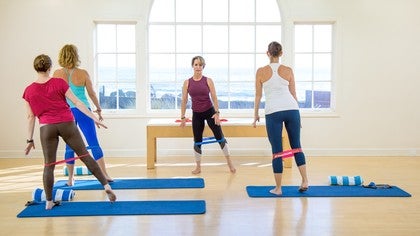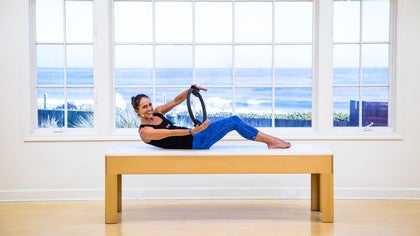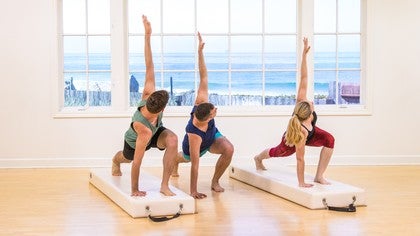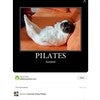Description
About This Video
Transcript
Read Full Transcript
Hi, I'm Myriam Kane. I am so excited to be back here at Pilates Anytime to share with you the second class in the series that I've designed for walkers, runners, hikers. Really helping us to reintegrate some of the primitive movements that we may have lost, we've all lost some of them along the way. And those are the things that contribute to the compensations that contribute to the breakdown or dis-integration of the joints and such in our bodies. The good news is, we can press reset and reboot just like we do on our computers, with certain movements that are very important.
So for this session, first of all, I hope you've been doing the first class so that you have some of the basic movements. If not, you can do that, maybe before you do this one. But regardless, a band is really all that you need. If you have circle bands you can grab one of those. But otherwise, you'll just tie this into a circle.
If it feels uncomfortable to use the band, just don't use it, and when you're ready you'll do it. We're gonna start with just a little warm-up that I like to do when I'm, and we don't need the bands yet, but when I'm either getting ready for a walk or run or a hike, typically I do it in a shoe, but I much prefer it barefoot. So we're just going to stand, feet parallel. Then we're gonna take, we're gonna unload, the right foot. We're gonna put the right foot back.
So we're balanced on the left foot and the right knee is pointing straight down. So it looks something like this. Kind of like I'm walking or running. But what we're going to do is imagine you have a pen sticking out of your knee and you're drawing on the floor a circle that's clockwise circle. And you're gonna let your foot, if you see what I'm doing with my foot, you're gonna let it go through these movements.
If you're not used to moving your feet like this or, busted, if you haven't been doing your homework and sitting on your toes, then this might be really uncomfortable, so maybe just make sure you have a padded surface. Then you're gonna reverse that. You're gonna go the other way. So all these little receptors in the joint are sending messages up to the brain, and the brain should feel like this is pretty safe, and it's deciding what to do with this, it's preparing us. Good, we'll do one more, and then we'll bring that foot down.
We'll do the other leg, so same thing. Feet are parallel, the other leg goes back, so your knees are pointing straight down, you got that pen sticking out of your knee, and you're gonna draw a counterclockwise circle. Back, you know what I meant (laughs). So we draw the circle, and you might notice, I know I do, I have had an injury that I didn't take very good care of, and so my pinkie toe stays somewhat holding a grudge, and I can feel it as I do this. I'm hoping we make friends as I do this.
And then we're gonna reverse it, so we'll go the other way. And you'll feel that maybe one ankle might feel different than another. And this shows up when we walk or run, okay? So just be aware. Beautiful, bring the feet back down.
Bring your hands to the quads and we're gonna do a baby squat back, so just a little squat, try to lift your sit bones a little bit. And we're just gonna reach the back of the knees back behind us, so we're straightening the back of the knees and going right and left. So we're doin' a circle with our knees. So this again, is just a loosener for the joints, so the bottom part of the hamstring might feel something behind the knee or maybe your top part of your hamstrings may feel something. And then you're gonna reverse it, no judgment.
Just really it's more of a way of checking in with your body in various ranges of motion you're gonna be using when you walk or run, and letting your joints know what's comin' up. Beautiful. And you're gonna bring it all the way back up to standing. We'll go ahead and use that right leg again, and we're gonna lift the foot up and out and bring it down. And then we're gonna cross the midline and out and bring it down.
So now, just a little hip opener. So as you bring that leg up you're gonna ask those hip flexors to only do what they need to do and not just grip. Sometimes we have uptight hip flexors. We can also focus on relaxing the foot, the one that's in the air that might be trying to help. And stop, reverse.
So then we go out to the side, different movement, might be a whole different ballgame. One of the things that I find very interesting is that within a particular line of muscles, like let's just say the frontline, we're using hip flexors to loosen up the hip. But even the front of the shin could think it needs to do the work. So we'll do one more, and, beautiful. Other leg.
Balancing on this leg, owning the ground. And as we covered before, we're pressing through this standing leg, we're holding our ground, so to speak, I almost didn't there. And if you don't, feel free to use a wall that's close by. We have gondola poles but I didn't offer it to these lovelies. But if you need one, by all means use one.
Eventually the balance gets bigger, better, better and bigger. And then reverse it, go the other way, and forward. So just notice, yeah, notice the little messages. You know, we have this attitude that we're supposed to be perfect and we're not, and we're never gonna be, so get over it. But we can try to optimize this movement system, and that's what keeps us long and young.
Long lives, young, yeah. You know what I meant again. Excellent, so now we're gonna bring the feet all the way back down. Okay, so let's take a deep breath. We talked earlier, or back in the original first mat class that we did together for walking and running and hiking, the importance of the breath being our first reflex.
Walking, running is really a series of reflexes. When everything's moving optimally that's all that it really is, all we have to do is stay upright. Breathing in through the nose, those two little holes, with the tongue at the roof of the mouth, we get much better diaphragmatic breathing, and then we exhale out. (breath sound) And again, deep breath in, and we exhale out. (breath sound) Now as we breathe, I want you to go ahead and allow yourself to fall forward and fall back.
Fall forward and notice what tries to catch you, and fall back. And fall forward, so it's not fair, I already know what is trying to catch me, but your toes might be a little overactive, possibly, maybe not, you might already be a rock star at this. But I want you to think of the X. We talked about the right shoulder and left hip and opposite shoulder and hip. That the right side of the brain works the left side of the body and vice versa.
This is creating a pattern and integrating the brain into our movements, very important. So as you feel this happening, can you bring more of your energy to the X and feel maybe a little bit better balance, maybe a little less toes, hopefully, right? And bring it all the way back. Beautiful, okay. We're gonna bring it all the way down to a seated position, and I'll sit over here.
And the feet are going to come together like this. We're gonna lift our hearts straight up, and then we're gonna take the leg closest to me and we're going back to that windshield wiper. The difference is, we're now gonna bring our hands behind us. If you remember, and we'll do this a couple times, we had our hands behind us last time. There's another difference we'll talk about in a minute, but right now, feet are gonna stay down.
And the bottom stays down. As you press through the feet, we're going to rotate. And we're gonna do this back and forth. Rotate again. Notice if there's just a little bit more ease on one side than the other.
Possibly some of the internal rotators on one leg or just one hip are a little bit more uptight, restrictive than the others. Something you wanna be aware of. That side must be doing something a little bit differently. And then we're gonna stop right where we are. We're gonna bring our hands forward, and we're gonna bring ourselves to a A quadruped position.
And then we're going to sit back onto our ankles. If you've been doing your homework, this is gettin' easier, isn't it? Isn't it great? And if you haven't 'cause it hurts, it's just gonna keep hurting and get tighter. So just, I try to encourage you, unless you've got pins and you've got a really good reason not to do this, this is very, very helpful.
It does get better, maybe put a little bit of padding underneath of your ankles. And then you're gonna come up to your toes and sit back onto those toes. Just try to spread the toes out. So the plantar fascia begins right underneath those toes, it goes all the way up the backline of the body, and ends right here at the forehead. So you could actually have a tight backline down at your feet that gives you migraines.
Go figure. And then we're gonna come up to kneeling. So from here, we're gonna bring one leg forward. We talked about trying not to swing that leg out to the side, and then we're gonna bring it back. We're gonna do it again.
We're gonna bring that leg forward, and then we're going to bring it back. We're gonna bring it forward and then the difference is, now you're gonna press through this leg, and if you want you can have something for balance. We're gonna come up to standing. And bring it back down. I'm gonna come down to the floor and do it with you.
And you probably don't wanna stand on your couch and do this at home, either. So we go from kneeling, we're gonna have that leg up, and we're gonna press through that leg, ground, and let's see if we can just balance on that leg. It'll get better as we go. And then we come back down, trying to take your time as you go down, come back to kneeling. Bring the same leg forward again, press through that leg, and come up.
Can you feel your backline? Your glutes are kickin' in, right? And back, so the glutes are supposed to be the strongest muscles in the body. But the way our culture is, not so much, right? We sit on them.
Bring this foot forward. We can reclaim that. And bring it all the way up, and bring that leg forward. All right, so both legs are forward, we're just gonna squat back, lift your sit bones up a little bit so you're feelin' a little bit of length behind those sit bones. And then come right back up, good.
The other leg, the one closest to me, is now gonna go back. So we come back down to half kneeling, we bring the other leg down to kneeling, we're gonna bring the leg that's closest to me forward. Press through that heel as you come up, and back. Back we go. So we should be on the other leg.
If you're not, just change. And, beautiful. Again, you're gonna bring this leg forward, you're gonna press through the heel of this leg as you come up. And back. You used to be able to do this with no problem, with a big old melonhead when you were a baby.
And do it again. So you'll do it again, we're just rebooting that system. Beautiful. And again, go on back, and back. Beautiful, one more time.
This time we'll stay up, and up we go, and we stay. Beautiful. Okay, so you ladies are gonna be facing me. And we're just going to squat back. I'd like you to have your band.
If you have a long band that works just great, make a circle out of it. Otherwise, you can go with one of our tried and true little circle bands. The heavier blue bands, their bands, are pretty darn heavy, so if you have any SI issues I would suggest not even using a band or using a light band. Or you can go with the blue band, either way. But regardless, we're gonna start with just doing simple squats, so we're gonna squat back and come right back up.
So we're squatting back, which is a hinge movement, we're gonna sit, sit, sit, sit in a chair, and we're gonna press right back up. And press through the glutes that we just warmed up. We're gonna sit, sit, sit, and then we're gonna come back up. And we're gonna bring those arms forward, and then as we extend the legs we're extending the arms. We'll do that one more time.
And come right back up. Now we're gonna squat, and we're gonna come back up one more time and we're gonna go that way with a wide squat. So you're gonna take a little wider squat, and then we're just bringin' this leg in. Then we're gonna go this way, pretty simple. Out we go, and bring it in.
It seems simple, but can you imagine the millions of things that are going through our bodies right now for us to do this? So we should appreciate. And back we go, and bring it in. Now we're gonna squat and squat in. And squat, and squat in, and squat get that butt back.
And so it's not knees forward. So if your knees ever hurt when you do squats, it's just you didn't use your butt. And back, mm hmm. Busted. But there's a solution, so that's exciting.
And squat, and just two more. We're gonna do one more, and we're gonna bring the legs and hold here. Now we're gonna squat again, but this time this leg's just gonna go out to the side. So we're gonna squat, and this leg goes up. And we're gonn squat, and this leg goes up.
Sorry, same leg, or we can alternate. It doesn't matter. And squeeze. So relax your foot, it doesn't look pretty. But it's okay, it doesn't always have to look pretty.
It's just, I don't want it to work. One more time, that looks pretty though, Martha. And last one, and squat and hold. Other leg. So we're warming up the glutes, agreed?
Two more. One more. And hold, bring the leg in. You don't need the band, really. But if you have it anyways, just hang on to it for a second.
So from here, we're just gonna go up on to the toes. And back down. And up on to the toes, and roll back through the foot. And up through the toes, and roll. The arms go up, and we all go back.
The arms go up, and the bottom goes back. Make sure your knees don't go forward. Up. And back. Up and back.
One more time. Up and we hold. We bring the arms right here. Legs would be extra credit. And we go up on to the toes (laughs).
And we start to drop the heel. So we're up on our toes, and we're just gonna prance. (breath sounds) Breathe, shoulders are down. Just take a peek inside at the little guys that start to talk that are trying to help, right? Two more.
Just be aware, tell 'em no thank you, we got this. One more. Nice, bring the heels down, come all the way up. A little extra somethin' somethin'. We add the band.
So the band, and first of all, this kind of work, this we should be able to do. I couldn't do this a year ago. It got my attention. 'Cause then I wasn't gonna be able crawl around with my peanut on the floor. My grandson.
So you could bring the band below your knees. It's a little bit more challenging than above the knees. No band is gonna still be working. Okay, gradual progression. So we don't go from zero to 60, actually we do, and that's part of what gets us in trouble, it's just part of our culture.
I want it, I want it now. But it took us awhile to lose it, and it's gonna take us awhile to reclaim it, okay? So we're gonna squat back, and then we're gonna come back up. So we get a feel for the band. As we go, this is super important, I want you to think, knees out.
Now, not knees way out. But just knees out. And you're gonna start to feel those glute medes working, yes?
Two more. We're gonna do one more, we're gonna hold here, and we're gonna take a big step that way. (breath sound) And then we're just gonna tap that toe. And then we're gonna squat into this leg. And we're gonna tap that one.
And we're gonna do all of that without arching our lower backs, hiking our shoulders to our ears, at least that's what I like to do. Just kidding. Back, not really, and back we go. Good. Now as you feel, I don't know that comfortable would be the word, but like you're owning it, then you're gonna go bigger, and then bring the arms out.
And start to feel those delts. Wake those arms up a little bit. (breath sound) Get that butt back. Remember, if you feel it in your knees you need to get your butt back further. Two more like that.
We're gonna do one more, hold it here, hold it here. Bring your hands down. We're gonna go down and then I want you to keep your legs here as you bring your whole spine upright. Not rounding, just upright, good. You're gonna turn your knees out.
You're gonna press out with the knees, out. So we could wake up the rotator cuffs. Pretend we have a band, or we could grab a band, but we won't do that yet. You should feel, if you poke around in here, and you should poke, that wakes up the hornet's nest, you should feel these guys workin', rotators, yes? Watch your alignment, make sure we're not just arching our backs.
Two more. And one, beautiful. Walk the feet in. Last but not least, we're gonna do a little four square. So you're gonna draw this rectangular square.
With the leg, that leg, you're gonna go to the front part of that square, this leg's gonna match it, this leg's gonna go to the back part, and back. So, forward, forward, back, back. Forward, forward, back, back. If your band rolls up it doesn't feel good, so bring it down (laughs). Adjust it, take your time, hit pause.
And forward, forward, back, and back. And forward, and forward, can you feel yourself changing the muscles that you're using, right? And back, good, you good? All right, we're stayin' right here, we're gonna go the other direction. Thank goodness there's only two.
So this side is gonna go forward and forward, back and back, so you're absorbing it with the muscles. You're not locking out your joints. That's one of the tricks of the brain. Remember, your brain, our brains, take in 75% information from the peripheral nervous system. And then 25% of this energy goes to deciding what to do with it.
One of the things it likes to do is lock out joints if it feels like there aren't muscles available for stability. So we're gonna just go ahead and bend those knees and let it know we got plenty. One more time, last one, and voila. Bring our feet together. We step out of the band.
You might feel like you have a little helium in your pants (laughs). It's a good thing, right? You feel how there's maybe a little bit more movement, and you wanna own that. Matter of fact, moving helps to integrate, and your brain's reshuffling what it just learned. So movement is very important.
You don't wanna do work and then just sit down. All right, beautiful. So now we're gonna take it back down to the floor, lying supine on our backs. And we're ready for a side twist. All you need is your long band, okay?
Coming back with control, with care, we roll all the way back. We're gonna bring our bands straight up. So the arms aren't on the floor to stabilize us anymore. We're gonna bring the right leg tabletop, left leg tabletop. We already know our hip flexors are relaxed, right?
And we're gonna just a little bit of pressure on the band. Just so the muscles under your armpits showin' up. We're gonna inhale, both knees go towards me. And we're gonna exhale to bring 'em back. So it becomes a little bit more about that X in the middle, doesn't it?
Inhale over. So we talked about that X, that center. When I do this, and I hope you too, can really feel that connection between right and left sides integrating, yes? All right, I'm gonna take that as a yes. Definitely.
Inhale over. And we exhale back. Inhale over, and we exhale back. We inhale over, we exhale back. One more time, inhale over, and we exhale back.
Beautiful. And we're gonna bring the right foot down, bring the left foot down, and let's just place that band nice and relaxed and open by our sides, but our hands are gonna have the bands down. So no tricking you, you know we're adding resistance, right? Take a breath. So either you do that or you don't.
Honor what your body's telling you, what you feel. And we exhale, we're go into a posterior tilt, and we begin to peel the spine up. So now we have that added gravity or resistance. I want you to reach your knees away. Give me a deeper posterior tilt.
So you should feel your glutes really firing up, hamstrings, and then you're gonna squeeze those knees together and release a little. Squeeze, and release. So those of us with tense hip flexors, and who doesn't in our environment, you're gonna feel a big stretch. But the beauty is, as you contract and release, the hamstrings and glutes are gonna start to balance that out. Two more.
And one more, we stay right there, and we're going to slowly come down vertebrae by vertebrae by vertebrae. You're gonna roll over onto your side towards me and bring yourselves up to a mermaid. So we've been doing our mermaid with our feet on the floor, we call 'em mermaid's windshield wipers. I guess it turns to a mermaid now when the feet go together into a fin. But, just kidding.
Hands are back, you're gonna take a breath. Now, first thing you're gonna do is you're going to lift your feet up. If your back or your SI joints aren't ready for that, then I want you to slowly just kind of slide your feet off to the side. Matter of fact, we'll do that anyways. Slowly start to unload your feet.
Let your brain get around all the little messages being sent, going oh my gosh, they've got their feet in the air. Is this a good thing? Yes, I'm sitting, I can't fall any further. Once you feel comfortable with that, you're going to bring your legs up and over. And then legs up and over.
And if you don't feel comfortable with that, don't do it yet, okay? Don't do it yet. You will, just takes a little time. Takes practice. Do not give up.
You didn't give up when you were learnin' how to walk. I'm done with this, said no baby ever, and you were a baby, so, no different. And we're gonna stay right here. Grab ahold of this foot, bring the opposite arm up, and we're just gonna lift way up high and over towards the outside foot. And reach.
That feels good, doesn't it? A little treat. You deserve it. And we're gonna go back up. We're not collapsing.
There's no real good value in collapsing, is there? We're gonna lift up and over. Oh, yes, relax this shoulder. Darn shoulders. And back.
Beautiful, we'll do one more like that. You wanna go up and over and just enjoy that. And all the way back, beautiful. We'll bring the legs over to the other side with our high mermaid. (breath sounds) And bring the arm up, take a breath.
We're gonna grab this leg and go way up high and over, and back. Take the time to enjoy this. Bring that arm up, it attaches to the lat that attaches into that Siberia called the thoracolumbar fascia, right? Which attaches to the glutes. There's a whole lot of opportunity for tension back there.
And up and over. And, beautiful, awesome. We're coming up to a kneeling position and we're just gonna need the band again. We're gonna bring that band right in front of us. So you ladies can face in.
And you're gonna pretend that you have a really good friend holding that band for you. Or maybe you do have a really good friend. Or maybe you put it around something that's not gonna move, like a banister. Take a breath, we go into thigh stretch. We're gonna go into a deep posterior tilt of the pelvis.
We are not gonna let this collapse as we fall back. We inhale, we pause. And we exhale to come back up. That's a tough one. Inhale, reach through your pinkies.
And as you exhale you go into a posterior tilt, we fall back. These are our going down the mountain when we hike muscles. Inhale. You know how those always hurt the most. And back we go, back we go, you're gonna inhale, you're gonna pause, and back up.
And you can play with it. See if you can go a little further on this last one. Deep posterior tilt, you go back, you go back, you go back, your brain says, but you're gonna fall, and you go, well, so what, right? It's not a big deal. And bring the hands down.
So it's okay to play with that and get comfortable with it. We're gonna bring the hands down, we're ready for chest expansion. So we're all stacked up, we take a breath, and as we exhale we're thinkin' armpits to the floor, fingers are loose, and back. And exhale back. (breath sound) And.
(breath sound) So we inhale through the nose, tongue to the roof, exhale through the throat. (breath sound) Two more. And we'll do one more. Beautiful, and bring the arms straight forward. Now we're going into a little bit of a row.
This will be like a goalpost you're creating. The forearm, they remain parallel to each other as we draw back. And we go straight forward as if our arms are on a table. We're gonna do this with intention, or it just feels like the arms are comin' back, and so what? So I want you to squeeze the back of your shoulder.
Ah, wake up, right? Squeeze the back of your shoulder, and we get a little bit of shake. Look at your forearms, and they should not be coming in like this. The brain says, but it's easier. Yes, it is, we'll give you that.
And, good. One more time, we're gonna come back, we're gonna hold right here. The elbows are out, we're gonna press out with the pinkie side of the hand. I want you to squeeze your shoulder blades together. Then draw them apart and come forward.
You're bringin' em back, you're gonna squeeze the shoulder blades together without using your arms. You're gonna think of elbows going wide. That cue always helps me, try that. We're gonna go back, we're gonna squeeze the rhomboids. Then we're gonna pull those elbows apart using serratus, very important muscles for shoulder stabilization.
One more time. Squeeze, my band is shaking, I must be doin' it deeply, all right. And then we'll do that one more time, we're gonna stay right here. We're gonna give ourselves a headband. Beautiful.
Then we're gonna drop it down and give ourselves a belt. External rotators, and internal rotators. And again, external rotators, and internal rotators. And one more time. And external rotators, back to where we started, bring the arms forward, and this is a band, so it has stretch.
We're gonna bring the arms overhead and without changing the position of our spine, 'cause you'll probably wanna arch, don't do that, you can stretch your band though, we're gonna bring the arm back to where you feel the deepest stretch. And stay right there. And then bring it right back up. And bring it forward. So we're doing this without lifting the shoulders up to the ears.
Upper traps not invited. And back up, and back down. We'll do that one more time, which should feel good on the shoulder. And if it doesn't, don't do it. And back up.
Okay, listen to what your body's tellin' you. If we honor what our bodies tell us they eventually give us what we'd like to have. If we try to force it we're not gonna win. And bring it back forward. Well done.
Now we're gonna back into our quadruped position. We're just gonna tuck that chin, roll through, bring the hands down with control. You've got a little bit of resistance on your band. With the arm that's closest to me you're gonna pull your elbow back. So the elbow's cocked up to the sky.
Then you're going to extend into a tricep extension and bend. The upper arm bone doesn't move, the humerus doesn't move. And bring it in, and out. And bring it in. Now the opposite knee is going to go out with the arm, and come in, and out.
Or it's not. You may just wanna think about this at first. Thinking about it gets the brain prepared. Ah, two more. And in, and one, hold.
Hold the leg up, bring the hands down. Armpits are down, you're gonna reach through the leg. You're gonna bend the elbows close to your torso as you come down, and back up. As if you're trying to kiss the floor. But you don't want to.
So stay stable, only go to where you can. And one more. And reach. Bring the knee down. We're not centipedes, thank goodness.
One other arm, here we go. Other arm comes up. We good? We're holding it lightly. We're gonna squeeze back.
And bring it in. Squeeze back, and bring it in. Give yourselves time to pause in the work so that the brain has a chance to memorize that it's okay. Then the leg's gonna extend with the arm, and bring it in. And the opposite ankle, the one that's on the floor, can you feel it trying to help?
Elbows are gonna bend in close. We're gonna come down, whoa, and press up. That was a tough one. In and press. Keep reaching through the leg.
And press. And I think we have one more. And press up, bring the knees in, come back into a rest position for just a moment. Don't get too excited, take a breath into your back. And exhale.
(breath sound) We're gonna bring it all the way prone, arms down by our sides. Just throw these guys down. And I want you to have your band. You don't have to use your band, but I want you to have it in case. Feet are pressed down.
We're in a deep posterior tilt so we don't use our lower backs too much. Knees are off, legs can be a little wider than hips, if that feels better to your body. Shoulders are away from the ears, elbows are down, forehead is down. We're gonna inhale as we lift our eyes, the face follows, bringin' the chest forward, and the elbows are gonna press down, but the forearm is gonna come up. And then we bring it back down, forearms down.
And we come back down. And we inhale. We come up, we come up. And we lift the forearms. Bring the forearms down.
And back down. Well, we're gonna continue with that. Wish I could do that, but I've added the band. We're gonna stay here, you can either continue with that, or you're gonna stay here and hold as you reach your band forward, out across your chest, and back. Back forward.
Cross your chest and back. And forward. And across, or you could be using just your arms without the band, that's a lot of work. And one more time. And forward, drop the band, bring the hands in, press up into a quadruped, curl the toes under, walk the hands up, and lift your sit bones up to the sky.
You're gonna drop your heels. I'm gonna come down to the floor with you. We're in our up stretch, which feels lovely. We'll prance a few times, lifting a heel and then the other, noticing if one side feels something different than the other. Being aware is good.
It's critical. And bring the heels down, walk the hands back, you're gonna bring your hands to your quads, but keep your back down. You're gonna draw the abdominals in, keeping your ribs down, to just round the lower back. This is all I've got. But this flexion for me.
You're gonna hold that flexion as you lift your heart and bring your thoracic into extension. You're gonna hold this as you round your lower back. You're gonna round this as you lift your heart. You're gonna hold this as you round your lower back. So, increments, and then you're gonna come all the way up.
(breath sound) Nice. We're gonna bring the legs wide. Yeah, take a nice deep breath in. If you can you interlace your fingers, if you can't it doesn't matter, you can just reach your arms up. We're gonna go that way.
We're gonna go up and over. The bottom arm is gonna grab the top wrist \and it's gonna pull. And bring it back. Same thing, other side. The head rests, and bring it all the way back.
And bring the legs together. Nice, deep breath in, fill it up. (breath sound) Bring the hands together, press them down in front your face, in front of your heart, always being grateful for what these amazing bodies can do. And thank you for joining us. Yay.
(applause)
Intermediate Mat Workouts: 30-Minute Classes
Comments
You need to be a subscriber to post a comment.
Please Log In or Create an Account to start your free trial.

























